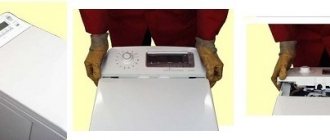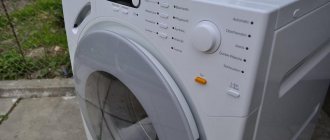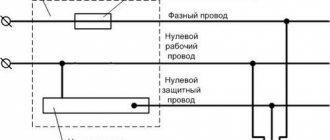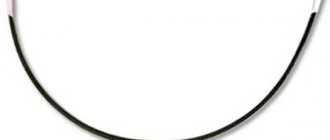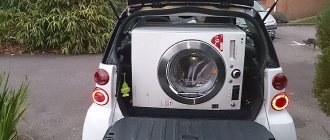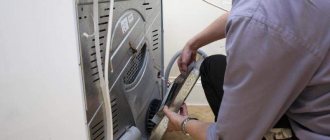Washing machine: how does it work?
First, it’s worth considering what parts a Samsung washing machine consists of. This determines whether the user can properly disassemble the Samsung machine. Typically they can be described as follows, regardless of the manufacturer:
- There are several panels inside. Front and rear, base versions are available.
- A tray of the appropriate type into which the products are poured and filled.
- The program panel is an essential component of machines, especially modern ones.
- Each model is equipped with a drum, couplings and a tank.
- Tank weights.
- Engine.
- Spring mechanism.
- Water pump.
- heating element.
- Pressostat.
Carrying out preparation work
Preparation for further disassembly of Samsung washing machines largely depends on the scheme in which the laundry is loaded - vertically, in the frontal version. Sometimes, to access the internal parts, it is enough to remove a special panel located at the back. This makes disassembly easier.
It is recommended to study in advance the electrical diagram and description of the main components for a specific model of a Samsung washing machine. Only after this can the owner begin the independent repair and disassembly process.
Before disassembling the Samsung washing machine begins, the following steps must be performed:
- First, the instructions are studied along with all the rules described in it. They tell you how to disassemble the case.
- Then you need to start preparing the appropriate equipment.
- At the next stages, the machine is completely disconnected from the supply of electricity and water. The drain hose and the outlet to the sewer must also be disconnected. Disassembly is easy here.
As for the equipment for disassembling a Samsung washing machine, it will consist of the following items:
- Long bent pliers.
- Insulated pliers.
- An ordinary type of wire cutter.
- Pliers and wire cutters used to process self-clamping clamps.
- Phillips head screwdriver.
- Flathead screwdriver.
- Wrenches for 19, 9 and 8.
- Service key. Without it, disassembly is impossible.
When disassembling a Samsung washing machine, you need to take into account that most of the parts are made of plastic. Therefore, you need to work carefully and carefully. Otherwise, the elements may be damaged and will have to be replaced, which will involve additional costs.
Recommendations from professionals
- Before disassembling, check again whether the water supply is stopped and whether the device is turned off from the network.
- There are many plastic parts in the machine that are easy to damage. Make sure that they do not break during disassembly.
- Take photographs of each dismantling step so you don’t forget the sequence later during assembly.
- Another way to help yourself during assembly: use felt-tip pens to mark the parts that you remove at a particular stage. You can write the number on the part itself, you can put it on a sheet (or sheets) of paper and sign the stage number next to it.
READ MORE: ▷ Comparison of Dishwashers: Features · Efficiency classes · General characteristics
Let's start the analysis
Automatic, semi-automatic modern washing machines in most cases are produced with front loading. Other types of devices have vertical loading. It is worth understanding the disassembly diagram for a Samsung washing machine in each case.
Front loading
Each manufacturer has certain features, but there is a procedure that always remains approximately the same:
- First, the top type panel is removed from the Samsung washing machine. We use a Phillips screwdriver to unscrew all the fasteners. The owner then carefully pulls the lid towards himself to remove it. The main thing is to be especially careful so that the parts do not break.
- Next, release the distributor recess. It is designed to be placed inside a powder or other type of cleaner. Press your finger on the special central area. At the next stage, the container is removed easily and simply. Disassembling the pump is not difficult.
- The control unit is also dismantled. First, the bolts are unscrewed from the top of the upper control panel. Particular care is needed when turning the blocks 90 degrees. Then all that remains is to remove this block from the neighboring mechanisms. Connectors and special wires are also disconnected. To do this, they are simply pulled out of special grooves, and disassembly continues.
- The service-type panel is located at the bottom of the front part of Samsung washing machines. When disassembling, it is also removed for a while during disassembly. To do this you will have to unscrew all the bolts on the sides. To remove the panel, you will need to carefully pry it open with a flat-head screwdriver.
- A rubber-based cuff is separated from the panel in the middle. You need to pry the clamp with a screwdriver. Then the entire part is freed from the grooves.
- The next stage is removing the counterweights during disassembly. In Samsung cars, such parts can be located both in front and behind. They look like blocks made of concrete. The design is designed to ensure that the washing machine does not make strong extraneous noise during operation. Long bolts are usually used for fastening. Without unscrewing them, you cannot temporarily get rid of the counterweights.
- The heating element is the heating element of a Samsung washing machine, which is removed next during disassembly. The back side of the lower part of the tank is where this part is located on many modern cars. The fixing nut must be opened first. And this detail is easy to find in the center. Next, press on the pin used when twisting the nut itself. Disassembling the drum is no more difficult.
The pin is pressed inward. You can tap the surface with a hammer if it is difficult to handle the work manually. The heating element is easily pryed off with a screwdriver having a flat end. Afterwards the element is carefully removed. Let's move on to the next stages of disassembly.
- The drive belt of a Samsung washing machine is also removable. It extends from the engine to the pulley. The latter, in turn, is connected to the tank. All wires inside the tank and motor must be removed. First, the fixing elements of the tank are removed, then they move on to the tank itself.
- The next step is to remove the panel in the center. This element is attached to the body with 4 bolts - these are the first to be removed. Then the panel itself is dismantled.
- The sunroof lock connector can be disconnected separately.
- The panel at the back is also removable if necessary. The pinch bolt and mounting screws must be removed. The disassembly ends.
Assembly is performed in the reverse order of all the steps described above. When assembling, it is important that each element is in its place. Any small mistake can lead to premature failure of the device. Therefore, while disassembly is underway, it is recommended to remember the exact locations. Then to disassemble the drain hose .
When loading vertically
Disassembling such devices can cause certain difficulties for a novice master. Here are just a few of the malfunctions that device owners encounter most often:
- The drum quickly loses balance during washing.
- The drum suddenly opens on its own.
- Corrosion of metal blocks. Then disassembling doesn't help.
Bearing failure is another major problem that almost every owner faces. You will need to disassemble the machine to fix the problem.
Disassembly proceeds in the following order:
- Unscrewing the screws from the side.
- Shifting the block towards the person doing the repairs.
- Disconnecting all wires.
- Pulling out the panel of the Samsung washing machine itself. Disassembly is complete.
The presence of the WF marking on the washing machine indicates support for the front loading type. WD – designation of the function of the built-in dryer. The accompanying documents help you understand how any device yourself
Samsung machines also have a serious drawback - they are unable to resist power surges in the Network. Because of this, the disassembly procedure is carried out.
